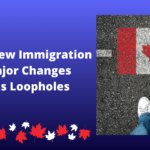In a surprising and impactful move, Immigration, Refugees, and Citizenship Canada (IRCC) has announced the immediate termination of the temporary public policy that allowed visitors to apply for work permits from within Canada. Effective August 28, 2024, this policy, originally scheduled to expire on February 28, 2025, has been cut short. While applications submitted before the cut-off date will still be processed under the now-defunct policy, the abrupt shift marks a significant alteration in Canada’s immigration framework.
The Background: Policy Introduction and Purpose
Introduced in August 2020 amidst the global COVID-19 pandemic, the temporary public policy was designed to address the immediate challenges posed by travel restrictions, lockdowns, and border closures. During this period, many visitors found themselves stranded in Canada with limited options for extending their stay or transitioning to a different status.
The policy provided a crucial lifeline by allowing visitors to apply for work permits without leaving the country. This flexibility was particularly important for those who had previously held work permits and faced job losses or disruptions due to the pandemic’s economic impact. By enabling these individuals to begin working while their new work permit applications were processed, the policy helped bridge a gap and offered much-needed economic relief.
The Decision to End the Policy
The sudden termination of the policy has been framed by IRCC as part of a broader strategy to manage the growing population of temporary residents and maintain the integrity of the immigration system. According to IRCC’s official press release, concerns were raised about potential misuse of the policy. Specifically, there were fears that the policy could be exploited by some to deceive foreign nationals into working without proper authorization.
IRCC’s decision reflects a focus on recalibrating the temporary resident population, which has surged significantly since the pandemic began. By tightening regulations, the government aims to align immigration practices with Canada’s long-term economic and social objectives.
Impact on Current Visitors
For visitors currently in Canada who were planning to apply for a work permit under the now-terminated policy, the immediate end is likely to cause considerable disruption. Those who did not submit their applications before the cut-off date will need to explore other immigration pathways if they wish to work in Canada. Here are some alternatives:
- Applying for a Work Permit from Outside Canada: Visitors can leave Canada and apply for a work permit from their home country or another country where they have legal status. This process typically involves securing a job offer from a Canadian employer and obtaining a Labour Market Impact Assessment (LMIA) in most cases. This path may require navigating additional administrative hurdles and waiting periods.
- Exploring Provincial Nominee Programs (PNPs): Various provinces offer immigration programs that can lead to permanent residency and, in some cases, work permits. Visitors can explore these options to determine if they qualify. Some PNPs may have specific criteria for work permits or permanent residency that could be advantageous.
- International Mobility Program (IMP): The IMP allows certain foreign nationals to work in Canada without an LMIA, though eligibility criteria are strict. This program might offer a viable alternative for those who meet the requirements.
- Studying in Canada: Enrolling in a Canadian educational institution can provide a pathway to a study permit, which may include work authorization. However, this option involves significant financial and time commitments, and it requires meeting specific educational and immigration criteria.
- Visitor-to-Permanent Resident Pathways: While rare, some immigration pathways allow visitors to transition to permanent residency, particularly if they have close family ties in Canada or meet specific humanitarian criteria. These pathways are highly selective and may require substantial documentation and proof of eligibility.
The Bigger Picture: Temporary Residents in Canada
The termination of the visitor-to-work permit policy occurs amid a significant increase in Canada’s temporary resident population. Recent statistics reveal that, as of 2023, Canada hosted over 800,000 international students and more than 400,000 temporary foreign workers. These numbers have continued to rise, contributing to growing concerns about the country’s capacity to manage such a large temporary population.
This influx has raised several challenges, including managing housing needs, providing adequate social services, and ensuring effective labor market integration. The government’s decision to end the policy can be viewed as part of a broader strategy to address these issues by tightening rules and ensuring that temporary residents are in the country through regulated and appropriate channels.
The Road Ahead: Adapting to the New Immigration Landscape
With the termination of the visitor-to-work permit policy, visitors in Canada must swiftly adapt to the new reality. Exploring alternative immigration pathways will be crucial for those who wish to remain in Canada or transition to work status. The immigration community will be closely observing how this decision impacts the broader landscape of temporary residency and what it signifies for the future of immigration policy in Canada.
As Canada continues to navigate the complexities of post-pandemic immigration, the government remains committed to maintaining a fair, transparent, and balanced immigration system. The end of this policy underscores the need for ongoing reform and adaptation in Canada’s approach to immigration, ensuring that it aligns with both economic needs and social objectives.
The swift termination of the visitor-to-work permit policy highlights the government’s effort to recalibrate the immigration system and address issues arising from the pandemic-era measures. While the policy offered flexibility during a challenging period, its end reflects a commitment to preserving the integrity of the immigration system and managing the temporary resident population more effectively.
As Canada moves forward, it will be essential for policymakers to continue focusing on reforms that balance the needs of temporary residents with the country’s long-term goals. This approach will help ensure that Canada remains a welcoming and well-regulated destination for those seeking opportunities within its borders.



